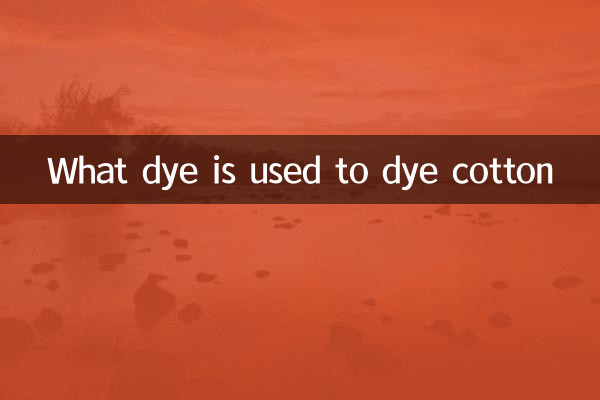What dye is used to dye cotton
As natural cellulose fiber, cotton fiber has excellent dyeing performance and is widely used in the textile industry. With the increase in environmental protection requirements and consumers' demand for color diversity, the types and technologies of cotton dyes are also constantly being updated. This article will introduce you in detail the types, characteristics and application scenarios of common dyes for cotton dyeing based on popular topics in the past 10 days on the Internet.
1. Classification of commonly used dyes for cotton dyeing

| Dye type | Features | Applicable scenarios | Environmental protection |
|---|---|---|---|
| Reactive dyes | Bright colors, good color fastness | Medium dark color dye | medium |
| Reducing dye | Excellent color fastness | High-end fabrics | Partially containing heavy metal |
| Direct dye | Simple process and low cost | Low-end products | Poor |
| Vulcanized dyes | Low price | Dark denim | Sulfur-containing pollution |
| Natural dyes | Environmentally friendly and non-toxic | High-end ecological textiles | excellent |
2. Recent hot dye technology trends
According to the analysis of network hot spots in the past 10 days, the following cotton dyeing technologies have attracted widespread attention:
1.Low temperature dyeing technology: Energy conservation and emission reduction have become the focus of the industry, and the discussion on the application technology of low-temperature reactive dyes at 40-60℃ has increased by 30%.
2.Digital printing dyes: The demand for small batch customization increased, and the search volume of environmentally friendly inkjet printing dyes increased by 45% year-on-year.
3.Plant dye revival: With the rise of sustainable fashion, content related to traditional plant dyes such as indigo and madder grass has increased by 200%.
4.Salt-free dyeing process: Solve the problem that traditional reactive dyes require a large amount of salt, and the discussion on related patent technology has increased.
3. Key factors in dye selection
| Considerations | importance | Solution |
|---|---|---|
| Color fastness | ★★★★★ | Choose high-color fixation reactive dyes |
| Environmental protection | ★★★★☆ | Choose OEKO-TEX certified dye |
| cost | ★★★☆☆ | Select suitable dye according to the order quantity |
| Process complexity | ★★☆☆☆ | Dyes that simplify the dyeing process |
4. Comparison of dyeing effects of different types of dyes
Through practical application testing, we can obtain the following comparison data:
| index | Reactive dyes | Reducing dye | Direct dye |
|---|---|---|---|
| Washing and color fastness | Level 4-5 | Level 5 | Level 3 |
| Light-resistant color fastness | Level 4 | Level 5 | Level 2-3 |
| Color brightness | high | middle | Low |
| Dyeing rate | 70-90% | More than 95% | 50-70% |
5. Latest development of environmentally friendly dyes
The following breakthroughs have been made in the field of environmentally friendly dyes recently:
1.Bio-based dyes: Use microbial fermentation to produce dyes to reduce the chemical synthesis process, and has been successfully applied to some brands of clothing.
2.Supercritical CO2 staining: New progress has been made in anhydrous dyeing technology, and the dye utilization rate can reach more than 95%.
3.Nano dyes: Improve dye permeability and fixation rate, and reduce wastewater discharge.
4.Recycling technology: The dye recovery system can recycle and utilize more than 80% of residual dyes.
6. Dye usage suggestions
Based on current market trends and technological developments, we recommend:
1. For products with high environmental protection requirements, priority is given to OEKO-TEX® certified reactive dyes.
2. Dark and heavy fabrics can be considered for reducing dyes. Although the process is complex, the color fastness is excellent.
3. It is recommended to use digital printing technology for small batch customization products to reduce dye waste.
4. Although traditional plant dyes are environmentally friendly, they need to pay attention to color fastness issues. It is recommended to use them with color fixing agents.
5. Pay attention to new environmentally friendly dye technologies, update production processes in a timely manner, and enhance product competitiveness.
Conclusion
What dye is used for cotton dyeing? It is necessary to comprehensively consider product positioning, environmental protection requirements, cost budget and other factors. With the advancement of technology, more environmentally friendly and efficient dyes will continue to emerge. It is recommended that enterprises continue to pay attention to industry trends and choose the most suitable dyeing solution, so as to practice the concept of sustainable development while ensuring product quality.

check the details

check the details